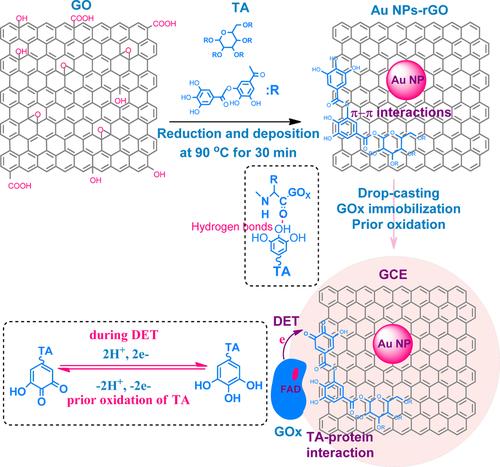当前位置:
X-MOL 学术
›
Electroanalysis
›
论文详情
Our official English website, www.x-mol.net, welcomes your feedback! (Note: you will need to create a separate account there.)
Tannic Acid Modified Electrochemical Biosensor for Glucose Sensing Based on Direct Electrochemistry
Electroanalysis ( IF 3 ) Pub Date : 2017-09-20 , DOI: 10.1002/elan.201700420 Bekir Çakıroğlu 1 , Mahmut Özacar 1, 2
Electroanalysis ( IF 3 ) Pub Date : 2017-09-20 , DOI: 10.1002/elan.201700420 Bekir Çakıroğlu 1 , Mahmut Özacar 1, 2
Affiliation

|
A novel glucose biosensor was constructed through the immobilization of glucose oxidase (GOx) on gold nanoparticles (Au NPs) deposited, and chemically reduced graphene oxide (rGO) nanocomposite. In the synthesis, tannic acid (TA) was used for the reduction of both graphene oxide, and Au3+ to rGO, and Au NPs, respectively. Also, by harnessing the π-π interaction between graphene oxide and TA, and protein-TA interaction, a novel nanocomposite for the fabrication of a third generation biosensor was successfully constructed. Upon the oxidation of TA to quinone, which is easily reducible at the negative potential range, enhanced electron transfer was obtained. The cyclic voltammetry (CV) results demonstrated a pair of well-defined and quasi-reversible redox peaks of active site molecule of GOx. The biosensor exhibited a linear response to glucose concentrations varying from 2 to 10 mM with a sensitivity of 18.73 mA mM−1 cm−2. The fabricated biosensor was used for the determination of glucose in beverages.
中文翻译:

基于直接电化学的单宁酸修饰的葡萄糖传感电化学生物传感器
通过将葡萄糖氧化酶 (GOx) 固定在沉积的金纳米粒子 (Au NPs) 和化学还原的氧化石墨烯 (rGO) 纳米复合材料上,构建了一种新型葡萄糖生物传感器。在合成中,单宁酸 (TA) 分别用于将氧化石墨烯和 Au3+ 还原为 rGO 和 Au NP。此外,通过利用氧化石墨烯和 TA 之间的 π-π 相互作用以及蛋白质-TA 相互作用,成功构建了一种用于制造第三代生物传感器的新型纳米复合材料。在 TA 氧化成醌后,在负电位范围内很容易还原,获得了增强的电子转移。循环伏安法 (CV) 结果证明了 GOx 活性位点分子的一对明确且准可逆的氧化还原峰。生物传感器对葡萄糖浓度从 2 到 10 mM 表现出线性响应,灵敏度为 18.73 mA mM-1 cm-2。所制备的生物传感器用于测定饮料中的葡萄糖。
更新日期:2017-09-20
中文翻译:

基于直接电化学的单宁酸修饰的葡萄糖传感电化学生物传感器
通过将葡萄糖氧化酶 (GOx) 固定在沉积的金纳米粒子 (Au NPs) 和化学还原的氧化石墨烯 (rGO) 纳米复合材料上,构建了一种新型葡萄糖生物传感器。在合成中,单宁酸 (TA) 分别用于将氧化石墨烯和 Au3+ 还原为 rGO 和 Au NP。此外,通过利用氧化石墨烯和 TA 之间的 π-π 相互作用以及蛋白质-TA 相互作用,成功构建了一种用于制造第三代生物传感器的新型纳米复合材料。在 TA 氧化成醌后,在负电位范围内很容易还原,获得了增强的电子转移。循环伏安法 (CV) 结果证明了 GOx 活性位点分子的一对明确且准可逆的氧化还原峰。生物传感器对葡萄糖浓度从 2 到 10 mM 表现出线性响应,灵敏度为 18.73 mA mM-1 cm-2。所制备的生物传感器用于测定饮料中的葡萄糖。


























 京公网安备 11010802027423号
京公网安备 11010802027423号